Media Law Essay: Defamation Analysis in Australian Media Law Context
VerifiedAdded on 2022/12/22
|6
|1319
|43
Essay
AI Summary
This essay provides a comprehensive analysis of defamation within the context of media law, focusing specifically on the Australian legal framework. The introduction highlights the importance of professional communication and the evolving landscape of journalism, emphasizing the need for adherence to ethical standards and relevant legislation. The core of the essay delves into the definition of defamation as a civil wrong, its implications for journalists, and the defenses available, such as truth and fair comment. It explores the impact of social media and moderation practices. The essay references key legislations and regulations, providing an overview of relevant case laws such as Lange v Australian Broadcasting Corporation and Dow Jones and Company Inc. v Gutnick, to illustrate the application of defamation law in practice. The conclusion summarizes the key aspects of defamation, reinforcing the need for media professionals to seek legal counsel when facing challenges related to content publication. The essay uses a variety of sources to support its arguments and to illustrate the complexity of defamation in media law.
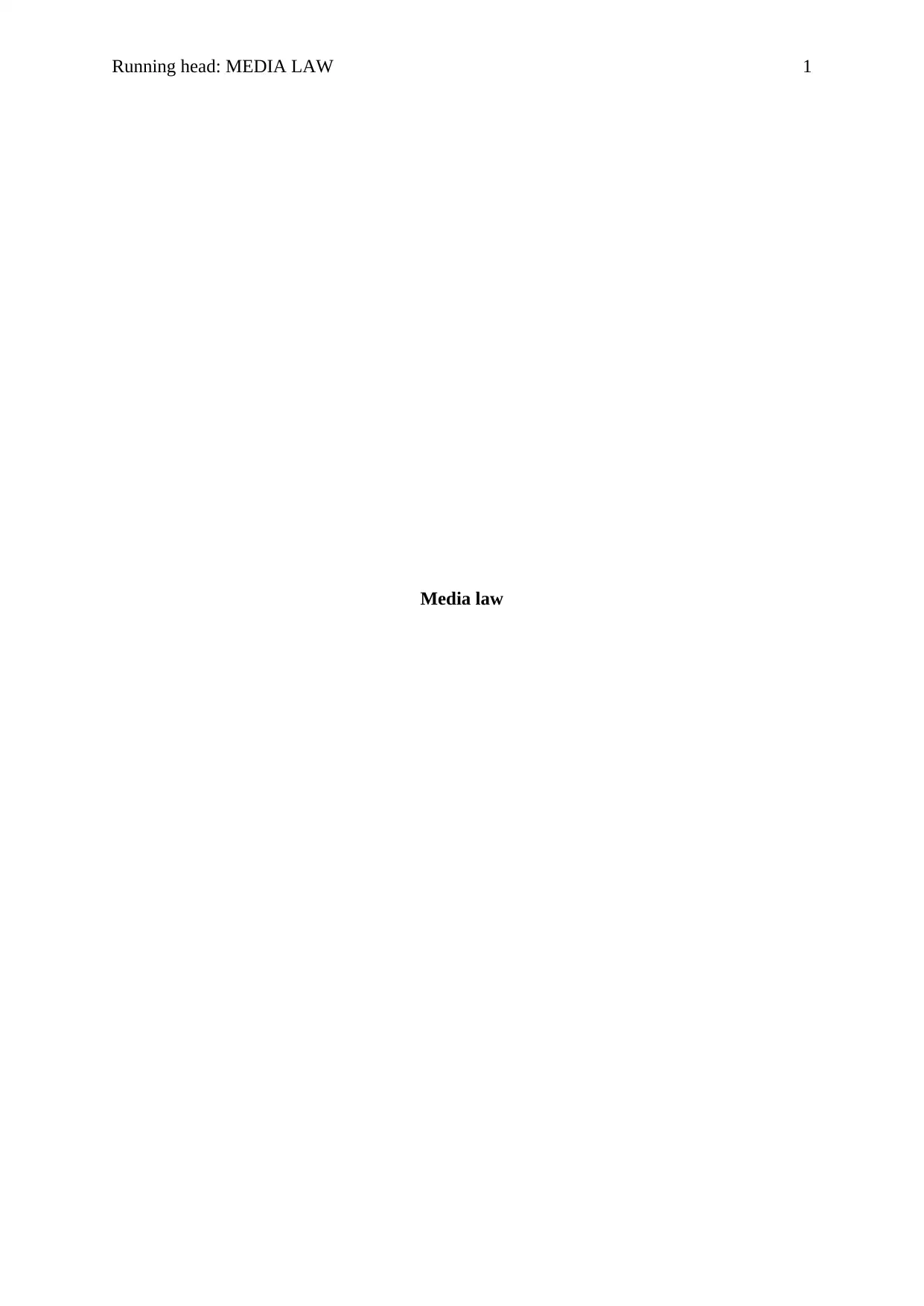
Running head: MEDIA LAW 1
Media law
Media law
Paraphrase This Document
Need a fresh take? Get an instant paraphrase of this document with our AI Paraphraser
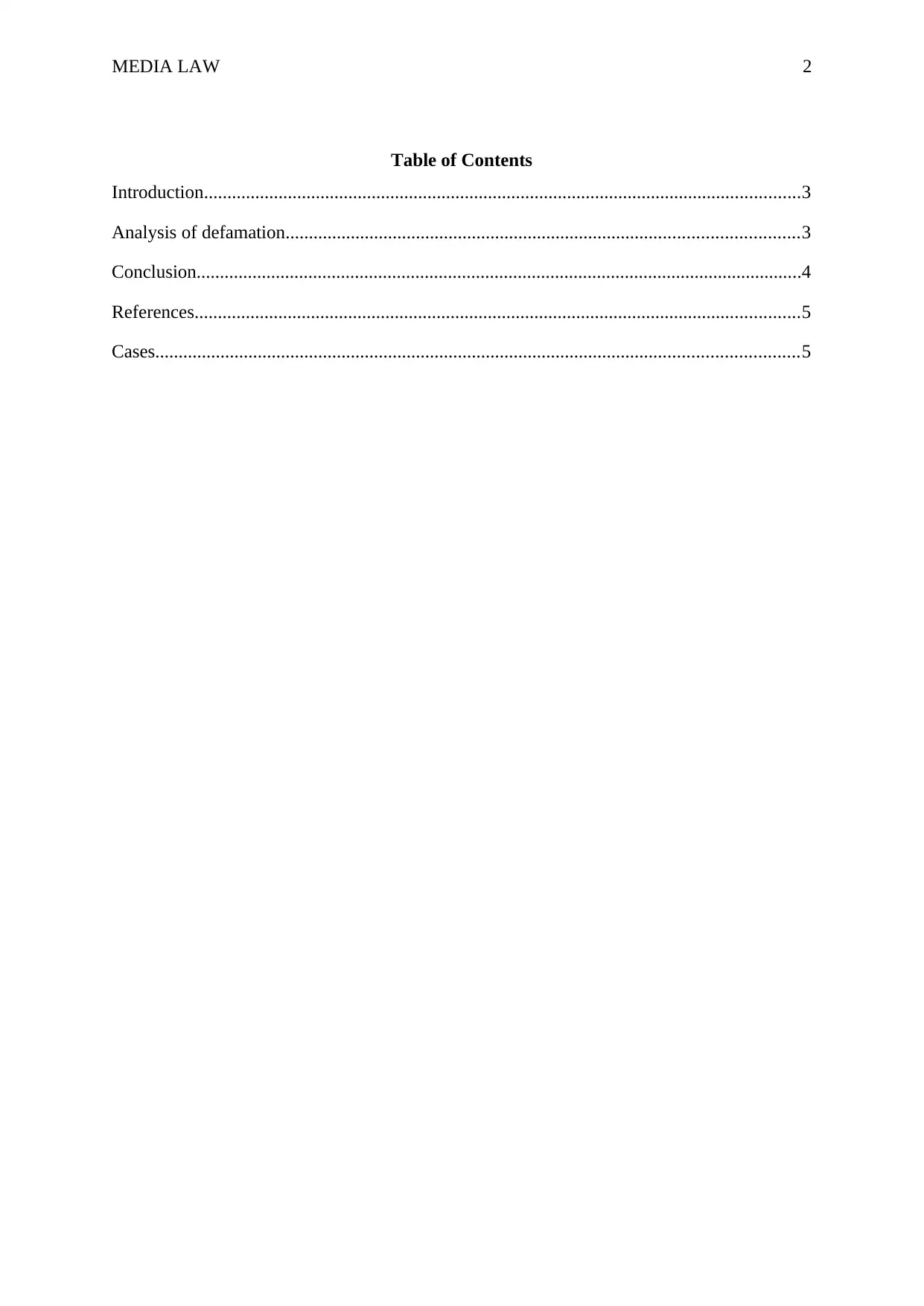
MEDIA LAW 2
Table of Contents
Introduction................................................................................................................................3
Analysis of defamation..............................................................................................................3
Conclusion..................................................................................................................................4
References..................................................................................................................................5
Cases..........................................................................................................................................5
Table of Contents
Introduction................................................................................................................................3
Analysis of defamation..............................................................................................................3
Conclusion..................................................................................................................................4
References..................................................................................................................................5
Cases..........................................................................................................................................5
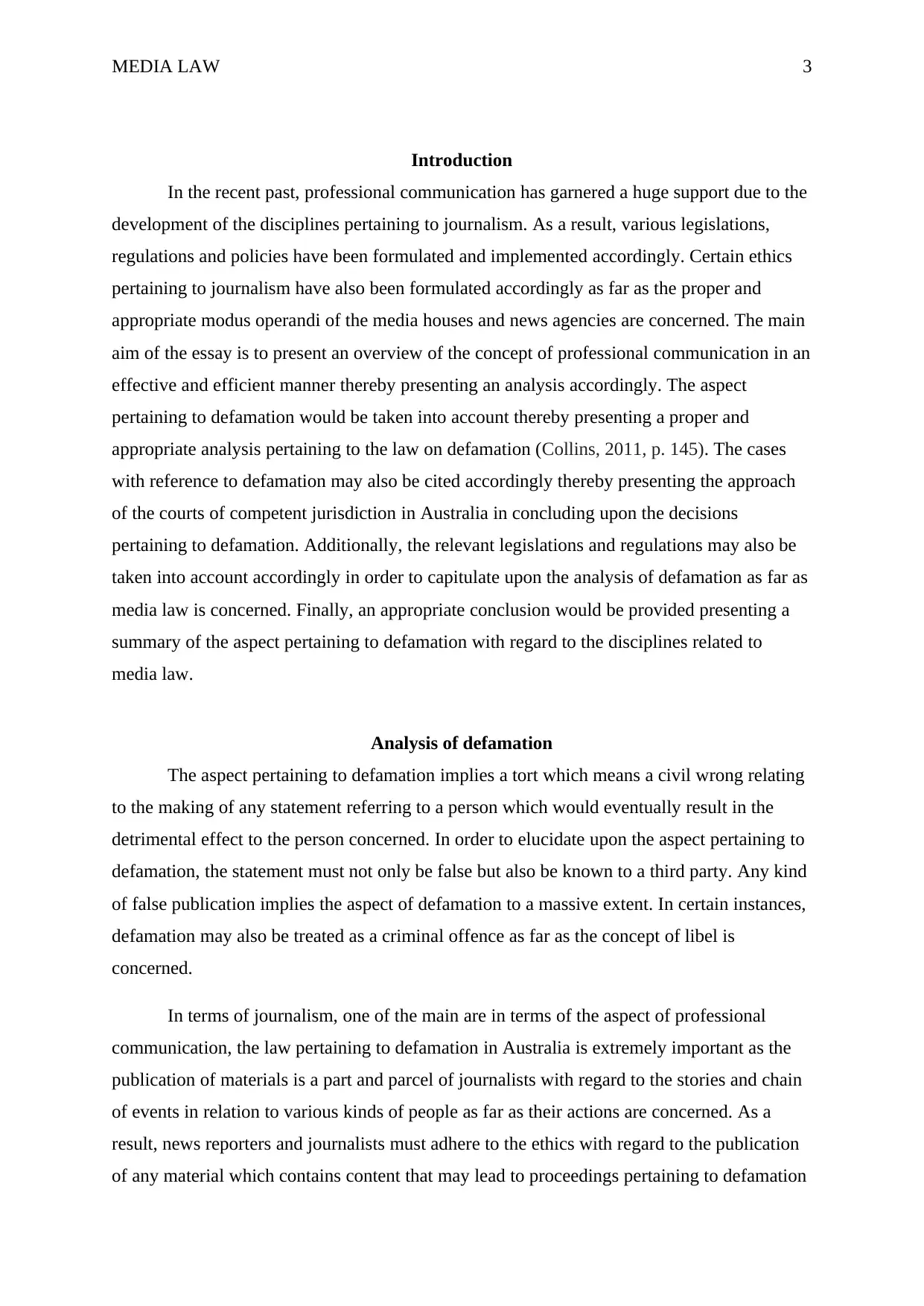
MEDIA LAW 3
Introduction
In the recent past, professional communication has garnered a huge support due to the
development of the disciplines pertaining to journalism. As a result, various legislations,
regulations and policies have been formulated and implemented accordingly. Certain ethics
pertaining to journalism have also been formulated accordingly as far as the proper and
appropriate modus operandi of the media houses and news agencies are concerned. The main
aim of the essay is to present an overview of the concept of professional communication in an
effective and efficient manner thereby presenting an analysis accordingly. The aspect
pertaining to defamation would be taken into account thereby presenting a proper and
appropriate analysis pertaining to the law on defamation (Collins, 2011, p. 145). The cases
with reference to defamation may also be cited accordingly thereby presenting the approach
of the courts of competent jurisdiction in Australia in concluding upon the decisions
pertaining to defamation. Additionally, the relevant legislations and regulations may also be
taken into account accordingly in order to capitulate upon the analysis of defamation as far as
media law is concerned. Finally, an appropriate conclusion would be provided presenting a
summary of the aspect pertaining to defamation with regard to the disciplines related to
media law.
Analysis of defamation
The aspect pertaining to defamation implies a tort which means a civil wrong relating
to the making of any statement referring to a person which would eventually result in the
detrimental effect to the person concerned. In order to elucidate upon the aspect pertaining to
defamation, the statement must not only be false but also be known to a third party. Any kind
of false publication implies the aspect of defamation to a massive extent. In certain instances,
defamation may also be treated as a criminal offence as far as the concept of libel is
concerned.
In terms of journalism, one of the main are in terms of the aspect of professional
communication, the law pertaining to defamation in Australia is extremely important as the
publication of materials is a part and parcel of journalists with regard to the stories and chain
of events in relation to various kinds of people as far as their actions are concerned. As a
result, news reporters and journalists must adhere to the ethics with regard to the publication
of any material which contains content that may lead to proceedings pertaining to defamation
Introduction
In the recent past, professional communication has garnered a huge support due to the
development of the disciplines pertaining to journalism. As a result, various legislations,
regulations and policies have been formulated and implemented accordingly. Certain ethics
pertaining to journalism have also been formulated accordingly as far as the proper and
appropriate modus operandi of the media houses and news agencies are concerned. The main
aim of the essay is to present an overview of the concept of professional communication in an
effective and efficient manner thereby presenting an analysis accordingly. The aspect
pertaining to defamation would be taken into account thereby presenting a proper and
appropriate analysis pertaining to the law on defamation (Collins, 2011, p. 145). The cases
with reference to defamation may also be cited accordingly thereby presenting the approach
of the courts of competent jurisdiction in Australia in concluding upon the decisions
pertaining to defamation. Additionally, the relevant legislations and regulations may also be
taken into account accordingly in order to capitulate upon the analysis of defamation as far as
media law is concerned. Finally, an appropriate conclusion would be provided presenting a
summary of the aspect pertaining to defamation with regard to the disciplines related to
media law.
Analysis of defamation
The aspect pertaining to defamation implies a tort which means a civil wrong relating
to the making of any statement referring to a person which would eventually result in the
detrimental effect to the person concerned. In order to elucidate upon the aspect pertaining to
defamation, the statement must not only be false but also be known to a third party. Any kind
of false publication implies the aspect of defamation to a massive extent. In certain instances,
defamation may also be treated as a criminal offence as far as the concept of libel is
concerned.
In terms of journalism, one of the main are in terms of the aspect of professional
communication, the law pertaining to defamation in Australia is extremely important as the
publication of materials is a part and parcel of journalists with regard to the stories and chain
of events in relation to various kinds of people as far as their actions are concerned. As a
result, news reporters and journalists must adhere to the ethics with regard to the publication
of any material which contains content that may lead to proceedings pertaining to defamation
⊘ This is a preview!⊘
Do you want full access?
Subscribe today to unlock all pages.

Trusted by 1+ million students worldwide
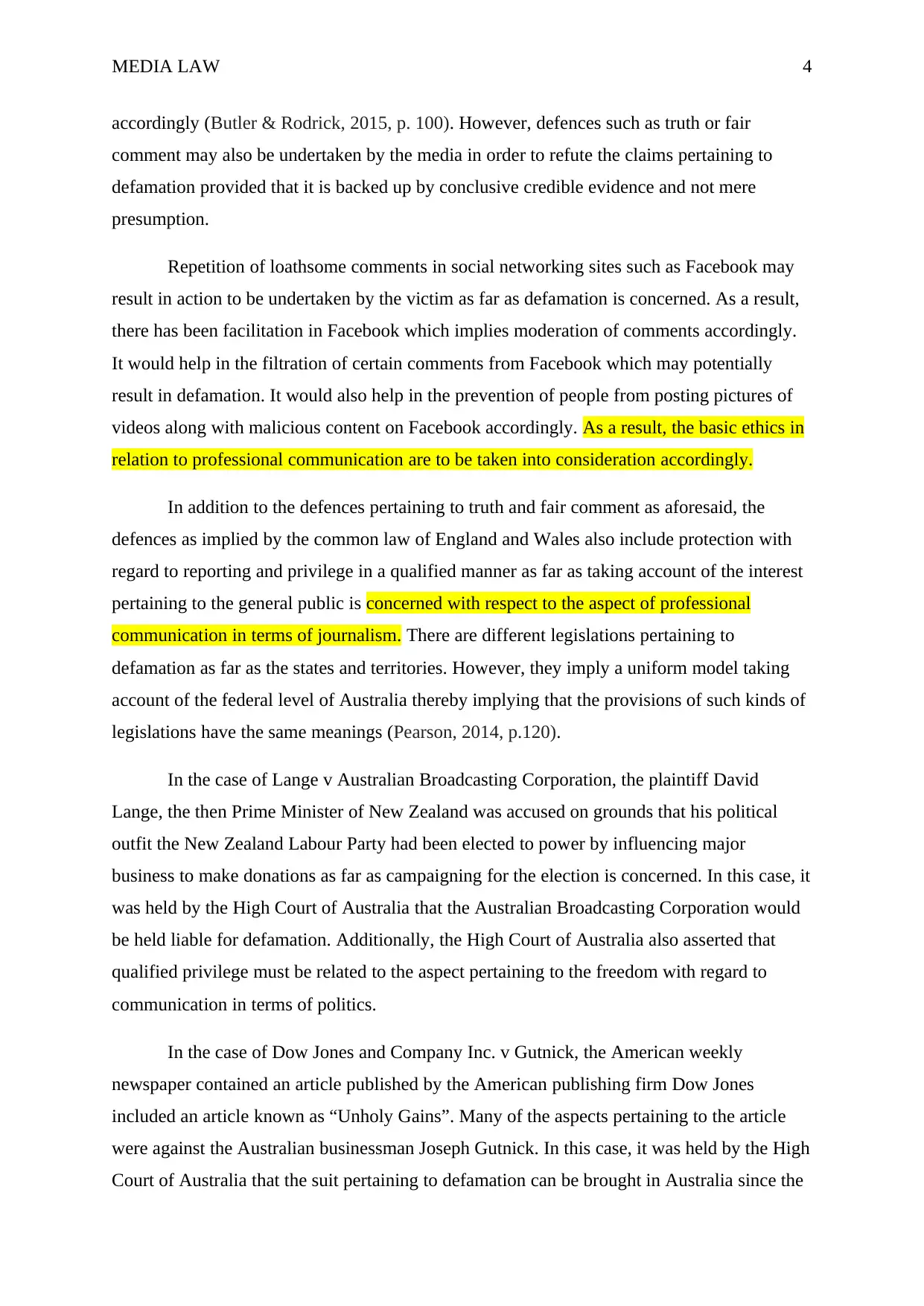
MEDIA LAW 4
accordingly (Butler & Rodrick, 2015, p. 100). However, defences such as truth or fair
comment may also be undertaken by the media in order to refute the claims pertaining to
defamation provided that it is backed up by conclusive credible evidence and not mere
presumption.
Repetition of loathsome comments in social networking sites such as Facebook may
result in action to be undertaken by the victim as far as defamation is concerned. As a result,
there has been facilitation in Facebook which implies moderation of comments accordingly.
It would help in the filtration of certain comments from Facebook which may potentially
result in defamation. It would also help in the prevention of people from posting pictures of
videos along with malicious content on Facebook accordingly. As a result, the basic ethics in
relation to professional communication are to be taken into consideration accordingly.
In addition to the defences pertaining to truth and fair comment as aforesaid, the
defences as implied by the common law of England and Wales also include protection with
regard to reporting and privilege in a qualified manner as far as taking account of the interest
pertaining to the general public is concerned with respect to the aspect of professional
communication in terms of journalism. There are different legislations pertaining to
defamation as far as the states and territories. However, they imply a uniform model taking
account of the federal level of Australia thereby implying that the provisions of such kinds of
legislations have the same meanings (Pearson, 2014, p.120).
In the case of Lange v Australian Broadcasting Corporation, the plaintiff David
Lange, the then Prime Minister of New Zealand was accused on grounds that his political
outfit the New Zealand Labour Party had been elected to power by influencing major
business to make donations as far as campaigning for the election is concerned. In this case, it
was held by the High Court of Australia that the Australian Broadcasting Corporation would
be held liable for defamation. Additionally, the High Court of Australia also asserted that
qualified privilege must be related to the aspect pertaining to the freedom with regard to
communication in terms of politics.
In the case of Dow Jones and Company Inc. v Gutnick, the American weekly
newspaper contained an article published by the American publishing firm Dow Jones
included an article known as “Unholy Gains”. Many of the aspects pertaining to the article
were against the Australian businessman Joseph Gutnick. In this case, it was held by the High
Court of Australia that the suit pertaining to defamation can be brought in Australia since the
accordingly (Butler & Rodrick, 2015, p. 100). However, defences such as truth or fair
comment may also be undertaken by the media in order to refute the claims pertaining to
defamation provided that it is backed up by conclusive credible evidence and not mere
presumption.
Repetition of loathsome comments in social networking sites such as Facebook may
result in action to be undertaken by the victim as far as defamation is concerned. As a result,
there has been facilitation in Facebook which implies moderation of comments accordingly.
It would help in the filtration of certain comments from Facebook which may potentially
result in defamation. It would also help in the prevention of people from posting pictures of
videos along with malicious content on Facebook accordingly. As a result, the basic ethics in
relation to professional communication are to be taken into consideration accordingly.
In addition to the defences pertaining to truth and fair comment as aforesaid, the
defences as implied by the common law of England and Wales also include protection with
regard to reporting and privilege in a qualified manner as far as taking account of the interest
pertaining to the general public is concerned with respect to the aspect of professional
communication in terms of journalism. There are different legislations pertaining to
defamation as far as the states and territories. However, they imply a uniform model taking
account of the federal level of Australia thereby implying that the provisions of such kinds of
legislations have the same meanings (Pearson, 2014, p.120).
In the case of Lange v Australian Broadcasting Corporation, the plaintiff David
Lange, the then Prime Minister of New Zealand was accused on grounds that his political
outfit the New Zealand Labour Party had been elected to power by influencing major
business to make donations as far as campaigning for the election is concerned. In this case, it
was held by the High Court of Australia that the Australian Broadcasting Corporation would
be held liable for defamation. Additionally, the High Court of Australia also asserted that
qualified privilege must be related to the aspect pertaining to the freedom with regard to
communication in terms of politics.
In the case of Dow Jones and Company Inc. v Gutnick, the American weekly
newspaper contained an article published by the American publishing firm Dow Jones
included an article known as “Unholy Gains”. Many of the aspects pertaining to the article
were against the Australian businessman Joseph Gutnick. In this case, it was held by the High
Court of Australia that the suit pertaining to defamation can be brought in Australia since the
Paraphrase This Document
Need a fresh take? Get an instant paraphrase of this document with our AI Paraphraser
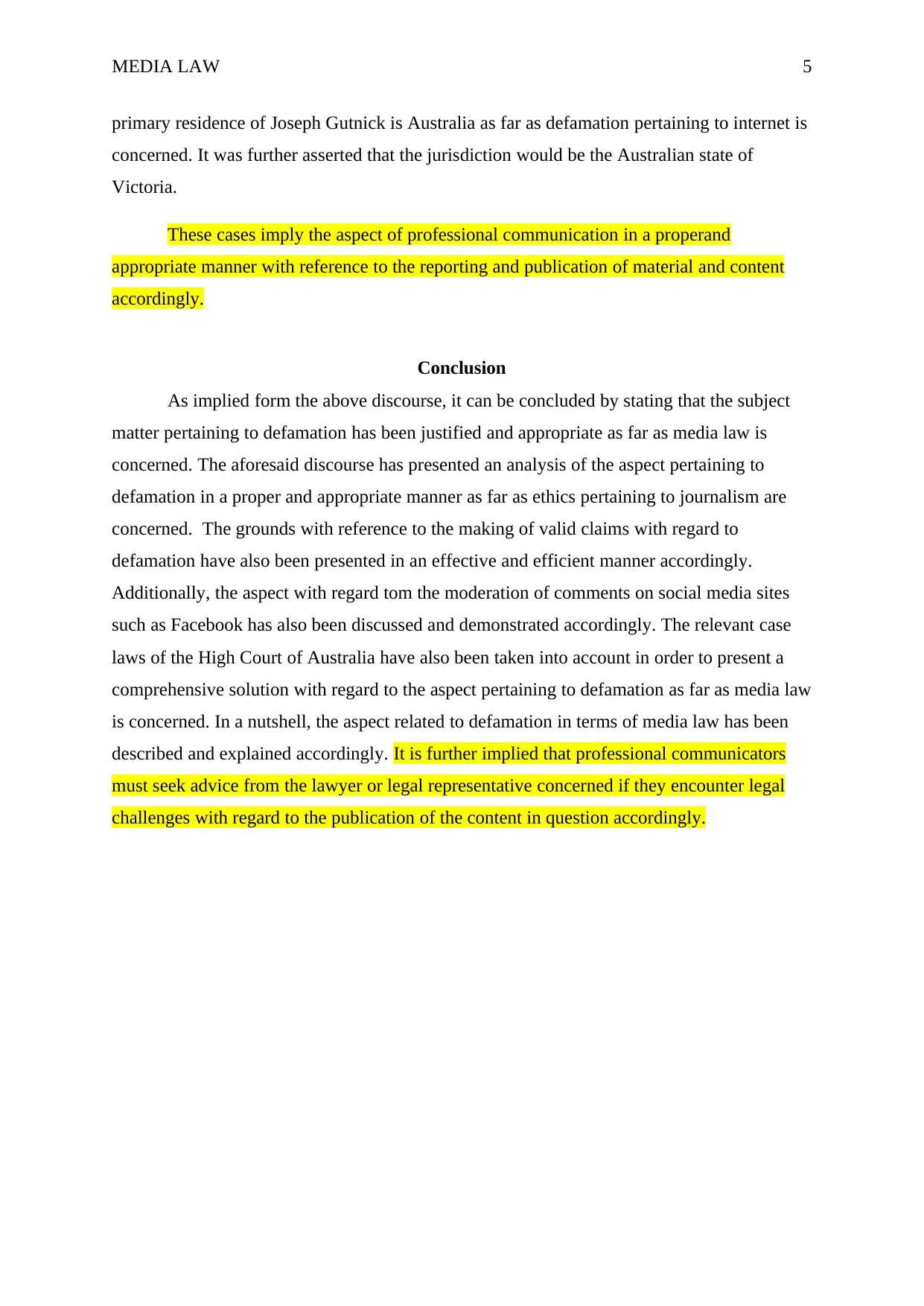
MEDIA LAW 5
primary residence of Joseph Gutnick is Australia as far as defamation pertaining to internet is
concerned. It was further asserted that the jurisdiction would be the Australian state of
Victoria.
These cases imply the aspect of professional communication in a properand
appropriate manner with reference to the reporting and publication of material and content
accordingly.
Conclusion
As implied form the above discourse, it can be concluded by stating that the subject
matter pertaining to defamation has been justified and appropriate as far as media law is
concerned. The aforesaid discourse has presented an analysis of the aspect pertaining to
defamation in a proper and appropriate manner as far as ethics pertaining to journalism are
concerned. The grounds with reference to the making of valid claims with regard to
defamation have also been presented in an effective and efficient manner accordingly.
Additionally, the aspect with regard tom the moderation of comments on social media sites
such as Facebook has also been discussed and demonstrated accordingly. The relevant case
laws of the High Court of Australia have also been taken into account in order to present a
comprehensive solution with regard to the aspect pertaining to defamation as far as media law
is concerned. In a nutshell, the aspect related to defamation in terms of media law has been
described and explained accordingly. It is further implied that professional communicators
must seek advice from the lawyer or legal representative concerned if they encounter legal
challenges with regard to the publication of the content in question accordingly.
primary residence of Joseph Gutnick is Australia as far as defamation pertaining to internet is
concerned. It was further asserted that the jurisdiction would be the Australian state of
Victoria.
These cases imply the aspect of professional communication in a properand
appropriate manner with reference to the reporting and publication of material and content
accordingly.
Conclusion
As implied form the above discourse, it can be concluded by stating that the subject
matter pertaining to defamation has been justified and appropriate as far as media law is
concerned. The aforesaid discourse has presented an analysis of the aspect pertaining to
defamation in a proper and appropriate manner as far as ethics pertaining to journalism are
concerned. The grounds with reference to the making of valid claims with regard to
defamation have also been presented in an effective and efficient manner accordingly.
Additionally, the aspect with regard tom the moderation of comments on social media sites
such as Facebook has also been discussed and demonstrated accordingly. The relevant case
laws of the High Court of Australia have also been taken into account in order to present a
comprehensive solution with regard to the aspect pertaining to defamation as far as media law
is concerned. In a nutshell, the aspect related to defamation in terms of media law has been
described and explained accordingly. It is further implied that professional communicators
must seek advice from the lawyer or legal representative concerned if they encounter legal
challenges with regard to the publication of the content in question accordingly.
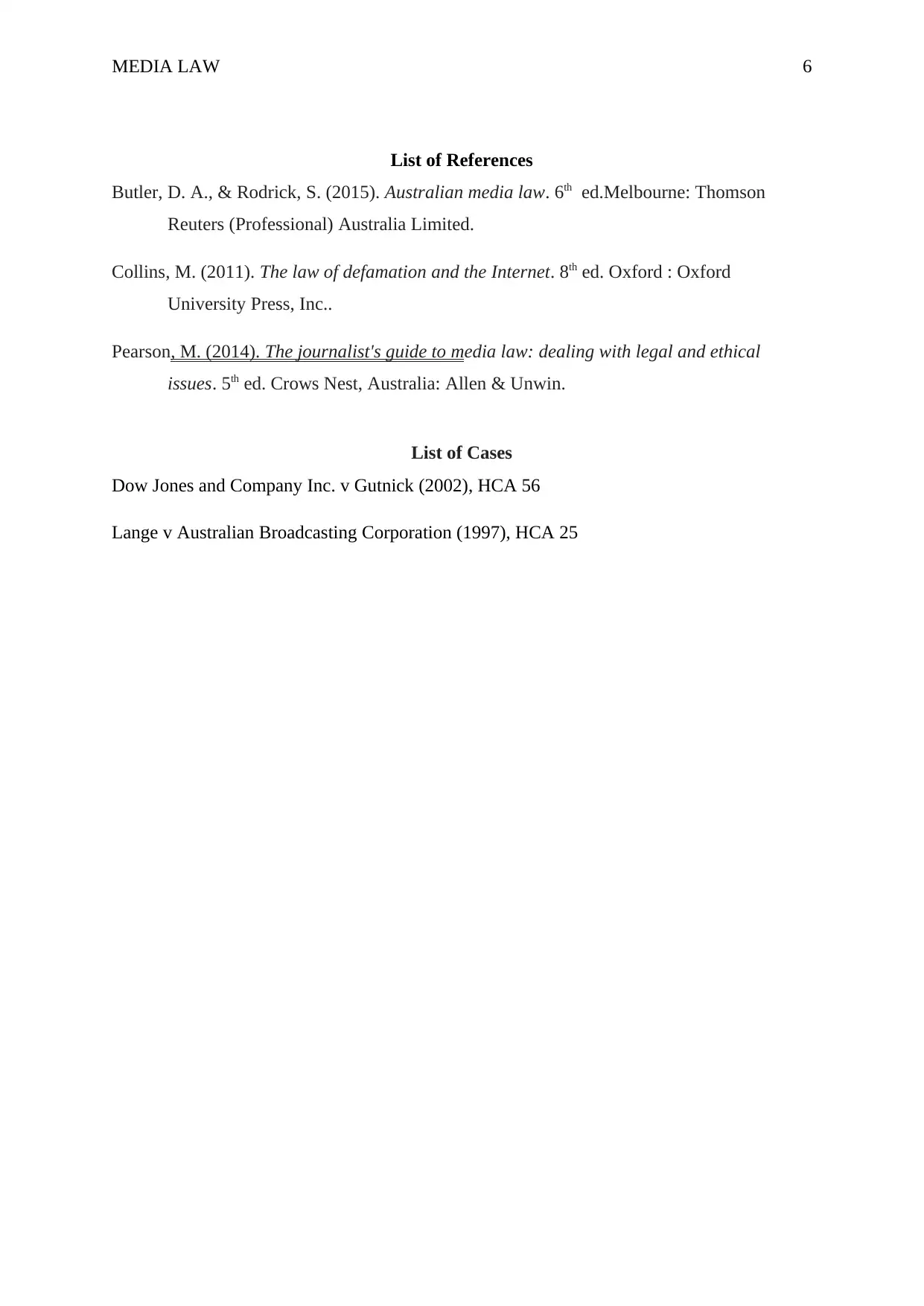
MEDIA LAW 6
List of References
Butler, D. A., & Rodrick, S. (2015). Australian media law. 6th ed.Melbourne: Thomson
Reuters (Professional) Australia Limited.
Collins, M. (2011). The law of defamation and the Internet. 8th ed. Oxford : Oxford
University Press, Inc..
Pearson, M. (2014). The journalist's guide to media law: dealing with legal and ethical
issues. 5th ed. Crows Nest, Australia: Allen & Unwin.
List of Cases
Dow Jones and Company Inc. v Gutnick (2002), HCA 56
Lange v Australian Broadcasting Corporation (1997), HCA 25
List of References
Butler, D. A., & Rodrick, S. (2015). Australian media law. 6th ed.Melbourne: Thomson
Reuters (Professional) Australia Limited.
Collins, M. (2011). The law of defamation and the Internet. 8th ed. Oxford : Oxford
University Press, Inc..
Pearson, M. (2014). The journalist's guide to media law: dealing with legal and ethical
issues. 5th ed. Crows Nest, Australia: Allen & Unwin.
List of Cases
Dow Jones and Company Inc. v Gutnick (2002), HCA 56
Lange v Australian Broadcasting Corporation (1997), HCA 25
⊘ This is a preview!⊘
Do you want full access?
Subscribe today to unlock all pages.

Trusted by 1+ million students worldwide
1 out of 6
Related Documents
Your All-in-One AI-Powered Toolkit for Academic Success.
+13062052269
info@desklib.com
Available 24*7 on WhatsApp / Email
![[object Object]](/_next/static/media/star-bottom.7253800d.svg)
Unlock your academic potential
Copyright © 2020–2025 A2Z Services. All Rights Reserved. Developed and managed by ZUCOL.





